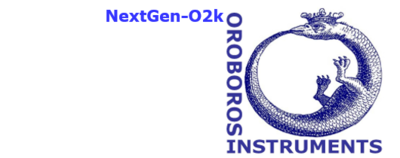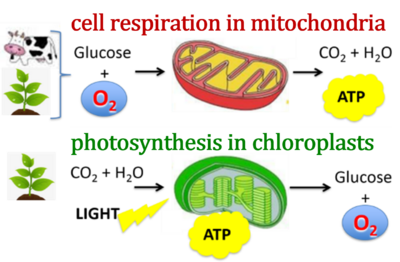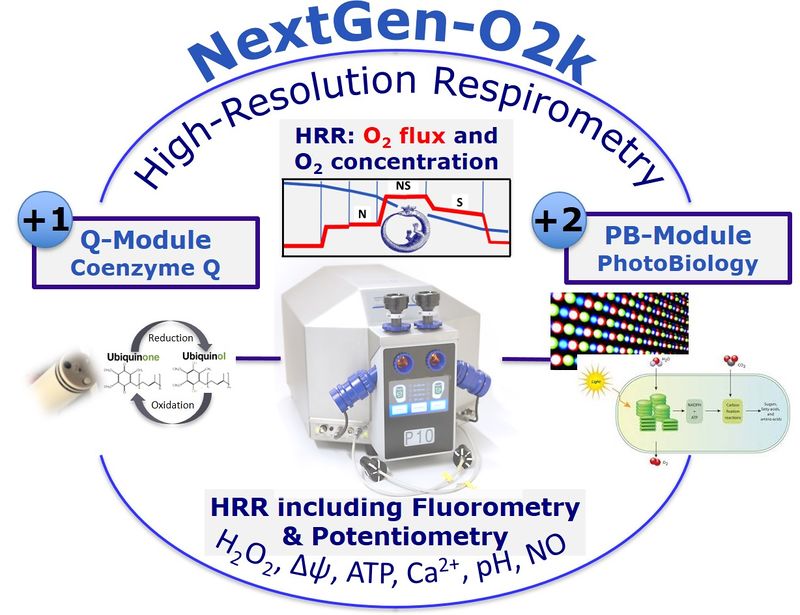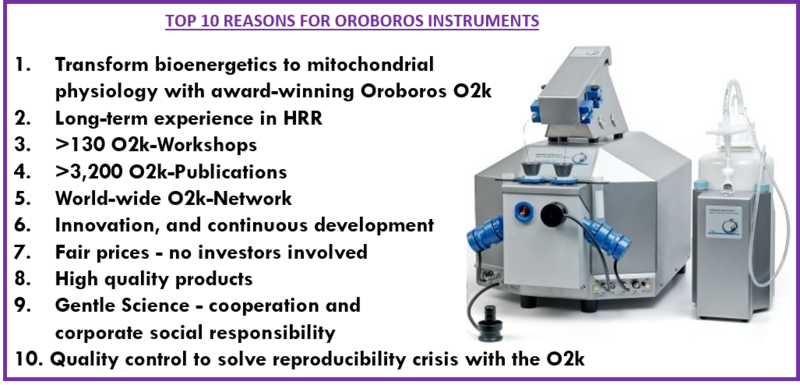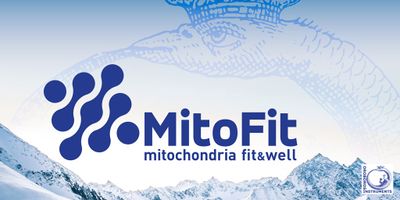The revolutionary all-in-one device to conquer mitochondrial disease
NextGen-O2k H2020-SMEInst
- Horizon 2020 Framework Programme Proposal: 859770 — NextGen-O2k
- EIC-SMEInst-2018-2020 — SME instrument phase 2
- The project Next-Gen O2k ist supported by the Standortagentur Tyrol and the FFG (Österreichische Forschungsförderungsgesellschaft)
- Duration of the action: 24 months
- Partners: About Oroboros, WGT Elektronik, SHTech, software security networks.
- Application: date ? ; Granted: date? (total budget € 2.35Mil)
Form the O2k to the Next-Gen O2k
O2k
- High-resolution respirometry (HRR) and unique combinations of the O2k with
- Fluorometry: the O2k-FluoRespirometer
- Potentiometry: the O2k-pH ISE-Module and O2k-TPP+ ISE-Module
- Amperometric measurement of nitric oxide: the O2k-NO Amp-Module
- High-resolution respirometry (HRR) and unique combinations of the O2k with
NextGen-O2k
- extend high-resolution respirometry (HRR) to the all-in-one device
- (+1) Cyclic voltammetry: the Q-redox sensor
- (+2) Controlled wavelengths and light intensity: PhotoBiology module
- extend high-resolution respirometry (HRR) to the all-in-one device
The NextGen-O2k project
- We have developed the NextGen-O2k, a multi-sensor all-in-one instrument for in-depth studies of: (1) the mitochondrial role in human diseases, and (2) mitochondria and chloroplasts ability in regulating algal growth and metabolite production rates.
- With the O2k core technology, developed exclusively by Oroboros for high-resolution measurement of oxygen flux, the NextGen-O2k integrates 2 new modules: (+1) A Q-Module to measure Q-redox states, and (+2) a PS-Module to study photosynthesis (PS).
- In just one device researchers obtain a snapshot of the mitochondrial/chloroplast metabolic profile, saving on experimental time, reagents and samples, minimizing errors and ensuring reproducible and accurate results. In addition, our instruments offer the highest oxygen sensitivity (5 nM detection limit) with an exceptional resolution (wide oxygen concentration range, between 0 - 1,000 μM) and robustness (>10 years lifespan), being superior to any other market option.
Building the highway to medical discoveries
- Mitochondrial research experiences a renaissance driven by its key role in pathological states. It is now established that mitochondria play a major role in cellular homeostasis and their dysfunction is key towards disease onset and progression. The figure below shows a variety of diseases where mitochondrial dysfunction has been detected and highlights its central role regulating cellular health and disease. To develop diagnostic and therapeutic strategies based on mitochondria, researchers need to understand mitochondrial function, morphology and dynamics, and its connections with key cellular pathways.
Algal Biomass production optimization by application of algal bioenergetics
- The use of algae (comprising cyanobacteria, microalgae, and macroalgae) for biotechnology has bloomed in the last decades, being used in multiple and highly relevant biotech fields.
- Algae-based food, animal feed, bioenergy, cosmetics, nutraceuticals and materials are considered by the EU as key for the development of a sustainable economy or bio-economy and circular economy due to multiple distinguishing features: (1) fast growth rate, (2) high biomass yields, (3) low land requirement for growth, (4) no competition for drinking water since algae can grow in seawater, and (5) contribution to the recycling of waste and mitigation of Climate Change (algae can grow using efflux gas from industry and wastewater).
- Wide adoption of algae for biotechnological applications is hindered due the poor understanding of algal metabolic pathways and function. The field faces the challenge of producing enough biomass for mass-market adoption and optimizing growing conditions of wild-type or transgenic strains to produce sufficient amounts of specific compounds of interest.
Integrative bioenergetic snapshot of the cell
- With the Phase 2 project we want to go one step forward and complete the development of a unique research instrument that provides an integrative bioenergetic snapshot of the cell.
- The NextGen-O2k combines High-Resolution FluoRespirometry with 2 new key modules to obtain a detailed bioenergetics profile and broaden the applications of our instruments.
- (+1) The new Q-Module for detecting the quinone redox state. Ubiquinone, or coenzyme Q or CoQ, and plastoquinone are essential mobile components of mitochondria and chloroplasts, respectively, that transfers electrons between respiratory and photosynthetic complexes of the electron transfer system (ETS). In collaboration with Prof. Anthony Moore (University of Sussex, UK), who described the use of a Q-redox sensor for mitochondrial characterization , we have developed a Q-Module for integrated analysis of the redox levels of the quinone pools (ubiquinone and plastoquinone). The level of reduction of the Q-pool is a function of the oxidative phosphorylation (OXPHOS) state in mitochondria. Therefore, OXPHOS deficiencies can be readily detected by measuring the deviation of the Q-pool with respect to normal respiratory and photosynthetic function. NextGen-O2k combines our O2k HRFR technology and the Q-Module for simultaneous detection of oxygen consumption/production and Q-redox state. The measurement of the Q-redox state is perfectly suited to detect mitochondrial dysfunction in pathological states and our opportunity to develop the first mitochondrial ‘all-in-one’ diagnostic device. The Q-redox state also plays a key role in photosynthesis, but continuous measurement in intact cells or chloroplast preparations has not been possible until now. The Q-Module will allow for the first time the continuous measurement of the redox state of the plastoquinone pool of chloroplasts simultaneously with oxygen production, therefore providing a better and more complete understanding of the algal bioenergetic control pathway.
- (+2) A PS-Module for measuring photosynthesis in algae and higher plants. We will include LED lights of specific wavelengths (i.e. actinic light) to stimulate the photosynthesis process. We will then measure O2 production due to the photosynthetic process, opening the application of the O2k technology to the fields of algal biotechnology and in the longer term to the research in higher plants cells. DatLab, unique and versatile software for easy and optimal use of our devices. An upgraded version DatLab pro of our current proprietary DatLab software will accompany the NextGen-O2k, designed for easy and accurate data acquisition and analysis. DatLab pro will be more user-friendly, including several optimizations, built-in protocols to facilitate data acquisition and analysis, and graphical tools. Datlab pro makes NextGen-O2k experiments easy and it is a unique asset of all Oroboros technologies.
Which problems does the NextGen-O2k solve?
Oroboros and NextGen
A unique development strategy
- Since our beginnings, Oroboros had a clear priority in mind: help scientists, make good science and push towards new revolutionary discoveries. For that, we have relied on a unique approach that has proven successful, with 1,100 instruments sold worldwide. The Top 10 reasons for Oroboros (Figure 7) show our value proposition and approach differentiation from competitors:
- Always deliver the highest quality standards: NextGen-O2k will combine sensors in one device to accelerate experiments and provide multi-data, but at the same time it will hold the highest oxygen resolution and sensitivity. We answer scientists’ demands who value high-quality data.
- Open-access strategy: Our website is a reference for mitochondrial research. We strictly follow an Open-Access policy, making available procedures, workshops & publications. We have built a worldwide network of users, fostering Open Innovation and communication among scientists.
- Continuous innovation, development and optimization. Since we launched the first O2k, we have worked hard to improve our products and meet the researchers’ needs. NextGen-O2k is the culmination of >25 years of development, innovation and continuous conversations with customers.
- The vision
- Be the scientific driving force in mitochondrial physiology
- Equip each biomedical lab world-wide with the NextGen instruments for research and diagnostic screening
- Support key developments in mitochondrial medicine
- Expand the business to biotechnology and ecology
- The vision
- The mission
- Enterprise and science
- Cooperation and feedback in science
- World-wide scientific network and collaborations
- Open-access resources and expert user support
- Corporate social responsibility
- QC to solve the reproducibility crisis with the O2k
- Mitochondrial fitness and benefits for health system
- Train our future inventors and start-ups
- New challenge: advance the bio-economy
- Enterprise and science
- The mission
Impact
Commercialisation

